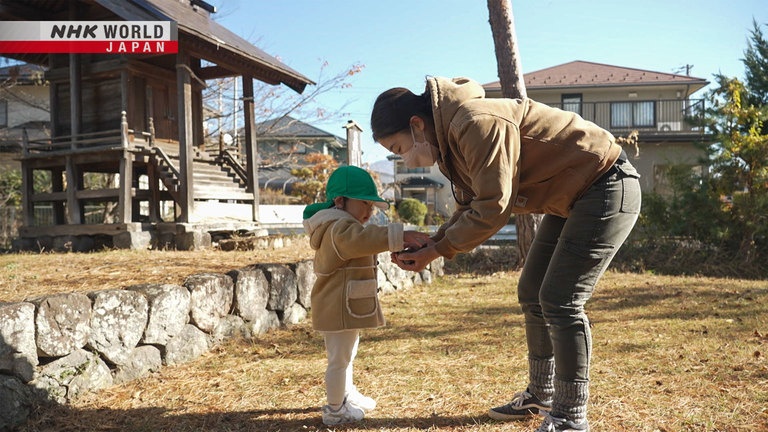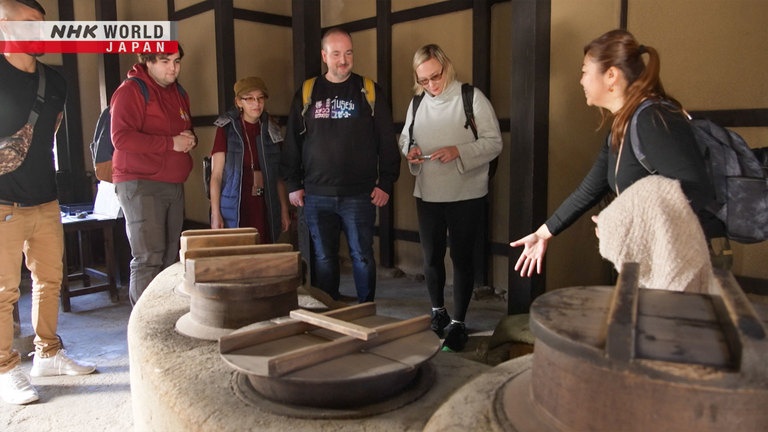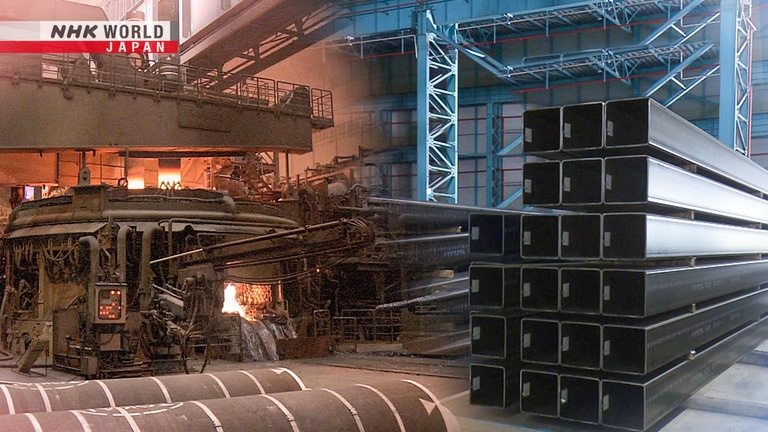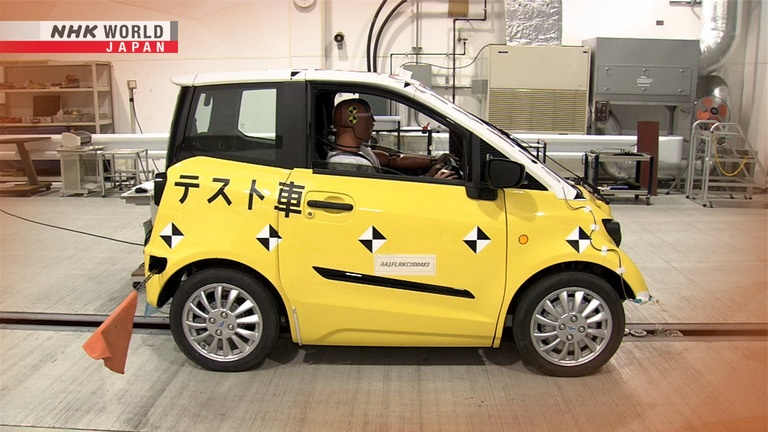Tourism with a Twist
As small towns with shrinking populations are looking for ways to attract tourists, many are hoping that unique tour services can help them to attract visitors from abroad as well as from within Japan.
[In Focus: Japan, Germany Pursue Different Paths to Economic Revival]
Two industrial powerhouses on separate continents face the common challenge of restarting an economy battered by the rising prices. We find out how different attitudes toward government debt in Japan and Germany are affecting strategies.
[Global Trends: Electric Furnaces for a Greener Future]
The steel industry is integral to the global economy. It's also one of the biggest contributors to CO2 emissions. We look at a technological advancement in Japan that's helping to reduce the sector's carbon footprint.
*Subtitles and transcripts are available for video segments when viewed on our website.
Tourism with a Twist

This nursery school exchange program is bringing entire families to towns located in Japan's countryside in the hopes they will establish a special connection to these local areas and keep coming back again and again.

Featuring friendly guides, this tour service focuses on having fun and adds a custom touch by having its guides balance their tours between famous locations and their own personal favorite spots.
Global Trends

As the steel sector increases efforts to decarbonize, a major Japanese player in the industry is turning to cleaner-burning electric furnaces for more of its output.

An EV startup is considering making car frames from scrap steel processed in electric furnaces. It hopes this will attract environmentally conscious buyers.
Transcript
Japan's Diet has approved a supplementary budget totaling about 90 billion dollars.
It's to pay for the government's new economic package.
"We are deploying all measures to prop up wages as a way to overcome rising prices."
But the budget raises worries that Japan's already dire fiscal situation could worsen further.
Nearly 70 percent of the spending will need to come from increased issuance of government bonds.
That drew criticism from the main opposition party.
"The plan includes lots of unnecessary measures, and it depends so much on issuing new debt."
"It puts the future of the next generation in jeopardy."
Japan's finance law prohibits the government from using debt issuance for fiscal management... except in special circumstances.
But in recent times, the exceptional has become the norm.
So Japan's deficit keeps growing.
Its debt-to-GDP ratio is overwhelmingly high among advanced nations.
By contrast, Germany ranks the lowest at about 65 percent.
But maintaining strict fiscal discipline is not an easy task.
A German government spending plan was abruptly halted last month after a constitutional court ruling.
The administration had planned to divert about 66 billion dollars of emergency borrowing
approved during the pandemic to finance the spending.
The court said that violates what is known as the Debt Brake.
It caps the government's fiscal deficit at 0.35% of GDP per year.
As with Japan, exceptions can be made in emergencies.
But in this ruling, the German court said emergency funds procured in the past
cannot be used for entirely different purposes in the future.
That leaves a big hole in the budget.
It may make painful spending cuts necessary at a time when the economy needs support,
including measures to combat rising energy costs.
The situation has left the country's leader trying to reassure people.
"Citizens can rest assured that the state will stick to the promises it made."
"We will not abandon anyone with the challenges we currently face."
At a time of rising interest rates, ballooning government debts are an even bigger concern.
But tight restrictions on spending also have a cost of their own.
This mill turns out steel that will go into items such as building frames and appliances.
Its raw material is scrap steel recycled from cars, drink cans and other products.
An electric furnace is used to melt the scrap.
It has a distinct advantage over the commonly used blast furnace when it comes to emissions.
Blast furnaces account for most of the crude steel manufactured in Japan.
They combine coke and iron ore in a process that releases massive amounts of CO2.
Electric furnaces use the heat of electrodes to melt scrap.
This is said to emit only about one quarter of the CO2 when producing the same amount of steel.
Efforts to decarbonize are driving demand for electric furnaces.
The volume of steel this company produces using them has increased by about 60 percent
over the past three years, amounting to 3.4 million tons in 2022.
As with many recycling processes, the quality of the source material is key.
Scrap steel tends to include other metals as well as impurities such as rubber and concrete.
This manufacturer has developed a technology to identify the makeup of the material categorizing it into six groups.
It adjusts proportions based on the steel product being made.
When scrap containing copper and chromium are placed in the furnace, a hard steel is produced.
On the other hand, adding scrap containing metals such as nickel
leads to a product that is resistant to cracking even when it's bent.
The right combination produces highly resilient steel.
We and our customers now embrace the idea that we cannot decarbonize unless electric furnaces are used to make steel.
We plan to expand our recycling of the scrap materials generated by society.
Recycled scrap metal is not usually associated with vehicle production.
But an EV startup is considering using the steel in its cars.
Car frames need to be lightweight to maximize driving performance and strong to ensure safety.
It's a combination that traditionally has been achieved through the blast furnace process.
These sections will bend as they should and absorb impact.
In a test, the vehicle runs into a wall at a speed of 50 kilometers an hour.
The frame sustains damage as expected but the passenger area remains intact.
The company will further analyze the data to confirm the level of safety.
The company expects an environmentally conscious approach will bring a competitive advantage.
People will know we are making efforts to reduce carbon emissions, including in the manufacturing process.
It will benefit us in the long run.
As pressure mounts on the steel industry to decarbonize,
more companies in the sector are recognizing that their future may rely on going electric.
This temple filled with lucky cats is now attracting droves of tourists.
A hidden spot introduced by a tour guide who wanted to share his favorite locations.
And a service that allows parents to send their children to local nursery schools is catching on
because it allows their families to visit different parts of the country.
Today's On-Site Report shows how some businesses are attracting visitors to rural parts of Japan.
The city of Ueda, in Nagano Prefecture, has seen a steady decline in its population over the last 20 years.
Okay, let's go!
Izawa Keichi and his family live in Tokyo,
but they are currently spending 2 weeks in Ueda and are sending their children to school
through a "short-term nursery school experience program."
The primary reason is to let their children experience a peaceful,
relaxing environment that isn't available back home in the city.
I thought it would be great to come to a place where we could easily visit natural hot springs,
drive out into the middle of the mountains, or just get out and be close to nature.
Izawa used a service that is similar to a travel site.
It allows users to choose from 38 nursery schools located across the country and to reserve stays of 1-3 weeks.
The package includes housing for the whole family and provides enough space for remote work to be done while the kids are at school.
This has allowed Izawa and his wife to come for an extended period of time without taking any time off of work.
And in their free time, the family can enjoy the abundant natural beauty of the surrounding area.
The total cost for a two-week package was approximately $2,400.
The service is managed by Yamamoto Masaya,
the CEO of a company that specializes in regional revitalization projects.
The farther out you get into the country, the more amazing the air and water become!
I want children from larger cities to be able to experience natural surroundings
that they just can't where they live.
After picking his son up from nursery school, Izawa decided to stop off at a local fruit shop for a special treat.
Since Nagano prefecture is famous for its apples, he got his son some freshly squeezed apple juice.
It's pretty good, right?
Izawa says he hopes to continue using the program
so he and his family can visit various locations across Japan together.
Since we can keep our kids in school, it allows us to travel out to rural areas - which we really enjoy!
Many of the participating schools are located in towns that want to attract new visitors.
A local housing manufacturer reached out to the "nursery school experience program"
and asked it to offer the service in Ueda with the aim of helping to revitalize the local economy.
I think there's a lot of potential to inspire visitors to relocate or even buy a second home here.
Since starting in May of 2023, the nursery school in Ueda has already hosted children from 32 families.
When you spend time in a community with your family, you develop a different kind of attachment to it.
Whether choosing a town as a second home, or just making it a regular vacation spot,
I think it's important to help form positive relationships between visitors and local communities.
The city of Nara is one of Japan's most popular tourist destinations.
Just 20km to the south, is Kashihara City,
the imperial capital of Japan from 694 to 710 AD.
Despite this rich history, it isn't known by many foreign tourists.
Recently, a unique local tour service has set out to change that.
On the day we visited, five travelers appeared at the local station to meet for a guided tour.
None of them had planned on joining a tour and were all traveling around different parts of Japan on their own...
When tour guides greeted them and offered them brochures explaining their service.
Today I will be the main guide, and I'm Akiko, Nice to meet you.
In addition to introducing key historical sights,
this service stands out due to its customized tours that encourage guides to mix in their own personal favorite locations.
The tour company is managed by Kiroku Takeshi.
He started the Kashihara tour service at the request of the Nara Prefectural government.
He first realized the appeal of tours with a personal touch about 5 years ago
when one of his staff took a tour group to a local temple he thought they might enjoy.
Unlike other temples, its grounds are covered with thousands of lucky cat figurines.
Not only was it a hit with the participants, but the photos they took of the temple's cute cat decorations went viral on social media.
A spot that was once only known by locals suddenly became a tourist attraction that draws in thousands of foreign visitors.
When we show foreigners around, we often notice the cultural gap between us.
For example, things that are a common sight for us, can often be extremely interesting for people from other countries.
Those are the kinds of places we try to take our guests.
On today's tour, Akiko first took them to an old district of Kashihara called Imai-cho,
which features row up on row of traditional buildings.
She especially wanted to take her group to...
-This is actually a pharmacy.
-Wow.
A 100-year-old pharmacy that still produces cold medicines and other products to this day.
But the purpose of the visit was to give everyone a chance to make a craft cola containing traditional medicinal herbs.
Twist! Twist!
Akiko hopes to leave an impact on her guests
by providing a fun and memorable way for them to experience traditional and historical sites around Kashihara.
Next, they visited a 400 year-old temple.
In total, the 3 hour-tour visited 7 different locations around the city.
The final stop? The 1,300 year-old Fujiwara Palace ruins.
They told me, we gonna go to the where the Japan was founded eating onigiri, I was like, oh my god.
Since starting in October, they have lead 25 tourists around Kashihara.
Nakanishi Yasuhiro, managing director of the Nara Visitor's Bureau, is happy with the response the tours have received.
If we can get 10 foreign tourists to visit a place they would have never visited before, that alone is a big deal.
The most important thing is to have visitors feel the places the guides select are interesting.